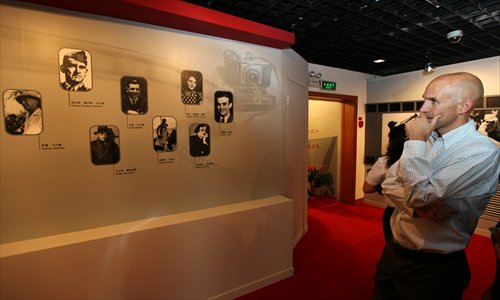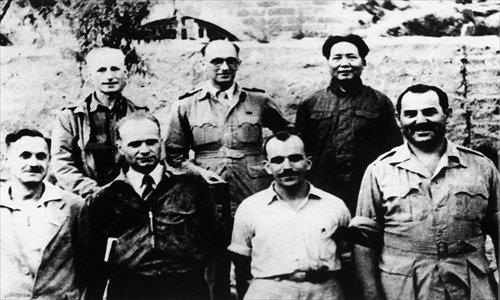A view from abroad

China between 1936 and 1948 was in one of its most turbulent periods. The country was invaded and torn apart. The stories of this time are well-known but a new exhibition throws light on some original insights and the firsthand accounts of 13 foreign journalists who came and worked in China at that time.
The bilingual exhibition in the exhibition hall at the Shanghai Municipal Archives Bureau in the Bund will be open till the end of this year. Over 100 exhibits are being displayed for the first time.
In June 1936 the famed American journalist Edgar Snow came to China looking for scores of answers to questions about the country and China's revolution. He went to the stark highlands of Northwest China looking for authentic soldiers and communists who were completely unknown to the West.
After four months he wrote Red Star Over China, a book that answered some of these questions. He is credited with being the writer who introduced Mao Zedong to the world. After Snow, other journalists from all over the world came to China looking for the facts behind the Chinese revolution and the Chinese communists. Through their books and reports, the world started to learn about the country and its new order.
"The true and objective reports made by these foreign correspondents of Red China and the Chinese communists during this period of time have become an integral part of history and always merit our memory," the introductory notes to the exhibition read.
A Zurich discovery
Shi Lei is the curator and said the idea for the exhibition came from a visit to Zurich in 2010 when he found a documentary that had been stored in the Archives of Contemporary History of ETH Zurich.
The 21-minute film that Shi Lei watched in Zurich had been shot by Walter Bosshard, a Swiss correspondent for the New Zurich Times, Life and Le Monde Iillustré in the 1930s. Bosshard was the first European journalist to interview Mao Zedong which he did in Yan'an, Shaanxi Province. The film he made may be the earliest film record of activities in Yan'an, the then center for the communist revolution.
Bosshard came to China in 1931 and in April 1938, after meeting Zhou Enlai in Wuhan and obtaining a special passport for Yan'an, he, and the American journalist A.Steele of the Chicago Daily News, went to Shaanxi with a convoy of trucks loaded with American goods. In Yan'an, Bosshard took a lot of photographs and shot a great deal of film, much of which has yet to be made public.
The film Bosshard made in Yan'an contained sequences of Chinese communist leaders like Mao Zedong living in cave dwellings, and also included scenes of ordinary people and activities in the revolutionary base like female students singing, soldiers training and eating.
The film was given to the Archives of Contemporary History of ETH Zurich by Bosshard's nephew after Bosshard died. "This film presented a picture of Mao Zedong to the West for the first time and it gave a wider perspective of the social status of the Chinese communist controlled area at that time," Shi said.
A rare film
In 2011 the Archives of Contemporary History of ETH Zurich donated this rare film to the Shanghai Archives and this inspired the Shanghai team to plan this exhibition showcasing how foreign journalists viewed and portrayed the early Chinese communists.
Shi and his team went to the US to look for more material. At Stanford University, Shi found a documentary shot by the United States Army Observation Group, or the Dixie Mission, the first US team to establish official relations with the Communist Party of China and the People's Liberation Army. Titled Mission to Yan'an, the documentary recorded daily life in the remote and isolated area. And in the Arizona State University Libraries, some 30 rare pictures taken by American journalists were collected.
The journalists who inspired the exhibition include the legendary Edgar Snow and his wife, Helen Foster Snow, who worked for the China Weekly Review, the London Daily Herald and the New York Sun; Agnes Smedley, an American correspondent for the Frankfurt Daily and the first foreign journalist who reported from the Chinese communist army frontline; James Bertram, a New Zealand correspondent for Daily Herald and Daily Telegraph, who wrote the only foreign firsthand account of the Xi'an Incident which was a turning point in the War of Resistance against Japanese Aggression (1937-45).
Edgar Snow was one of the best-known Western journalists in China. Snow arrived in Shanghai in 1928 and worked as assistant editor for the China Weekly Review. Later he joined the New York Sun and Daily Herald while teaching part-time at Yenching University in Beijing.
In 1931 Edgar Snow met Soong Ching-ling (the wife of Sun Yat-sen) and Lu Xun, the famous Chinese writer. Under their influence, Snow developed a deep understanding of China's revolution. In 1937, Snow completed his book Red Star Over China after a four-month sojourn in Yan'an. This book remains a classic example of foreign journalistic coverage.
The following year Snow's wife Helen went to Yan'an to interview high-level Chinese communist leaders including Zhu De, the then commander-in-chief of the Red Army. And she wrote Inside Red China, a sequel to Red Star Over China.

Adopted by the army
Shi Lei told the Global Times that there were many moving stories behind Snow's photographs. One that left a considerable impression was the story of a young Red Army soldier named Wang Dongping, who was Snow's bodyguard.
Snow wrote about him, explaining he had been an orphan and had been adopted by the Red Army when he was just 12. He was later captured by Japanese while he was carrying out surveillance and Japanese soldiers broke all his teeth.
Anna Louise Strong, an American journalist and author who visited China several times from 1925, published many articles and news reports in mainstream American newspapers and magazines documenting the War of Resistance against Japanese Aggression in China.
On August 6, 1946, Strong interviewed Mao Zedong in Yan'an. It was then that Mao made the famous statement that "all reactionaries are paper tigers," which, thanks to her report, became an universal expression. When the former US president George W. Bush made a speech after the 9/11 attacks, he declared that the US was not a paper tiger.
Other journalists featured in the exhibition include Israel Epstein, a Jewish writer who was born in Poland but settled in China in 1917 with his parents. After the War of Resistance against Japanese Aggression broke out, he worked as a correspondent for United Press International visiting war zones throughout China.
Epstein returned to China after the People's Republic of China was founded in 1949 and was given Chinese nationality in 1957. He became a member of the Communist Party of China in 1964 and was elected a Standing Committee member of the Chinese People's Political Consultative Conference in 1983. Although Epstein suffered persecution during the Cultural Revolution (1966-77), he remained dedicated to communism until he died.
In 1944, the German-born American journalist Gunther Stein visited Yan'an with six other journalists. He was working for the Associated Press, the Manchester Guardian and the Christian Science Monitor. During the visit, Stein had 30 hours of extensive personal interviews with Mao Zedong. Later he wrote a series of major articles and a book, The Challenge of Red China.
As well as these prominent figures the exhibition features some lesser-known writers including Evans Fordyce Carlson, an American marine officer who once served in Shanghai and made a detailed analysis of Chinese army battles especially involving the Eighth Route Army, one of the main military forces of the Communist Party of China in the 1930s and 1940s.
In 1938, he interviewed Mao Zedong, Deng Xiaoping and other communist leaders and published his book Twin Stars of China in 1940. In 1942 he led the Second Marine Raider Battalion, which he had formed based on communist army principles, in a series of assaults on Japanese forces. He is reported to have introduced the phrase "gung-ho" to the West.
Two other figures were Jack Belden, an American who came to Shanghai in 1933 and worked as a correspondent for United Press International, and the Jewish writer Hans Shippe who came to China in 1925.
Belden went to Anhui Province to write about the New Fourth Army, the communist army active in South China at the time. There he interviewed soldiers and took many photographs of their daily lives. His book China Shakes the World was published in 1949.
In the book he wrote: "Communist success was founded on empirical psychology and not on any pretentious political philosophy. The Celestial Reds won the people to their cause not by any process of reasoning, but by arousing the hope, trust and affection of the peoople."
Shippe also wrote about the New Fourth Army and interviewed the communist leaders Zhou Enlai and Liu Shaoqi in 1939. Later he joined the communist armies and died a martyr in the Yimeng Mountain area in Shandong in 1941.
Out of curiosity
Cao Lifeng, a researcher into the history of the Communist Party of China, told the Global Times that most foreign journalists came to China at that time out of curiosity. But the longer they stayed in China, especially when they stayed with communists, the more they started to understand China and its revolution.
"I remember Edgar Snow had 79 questions to be answered for his book Red Star Over China, when he first arrived in Yan'an and met Mao Zedong. Anna Louise Strong just wanted to learn who were communists and what was communism when she came to China. But by their later work, they obviously knew a great deal about Chinese communism," noted Shi Lei from the Shanghai Archives.
Cao said these foreign journalists had different skill fields and their stories, books and articles were like a door opening to the world so it could learn about Chinese communism and help today's Chinese remember history.